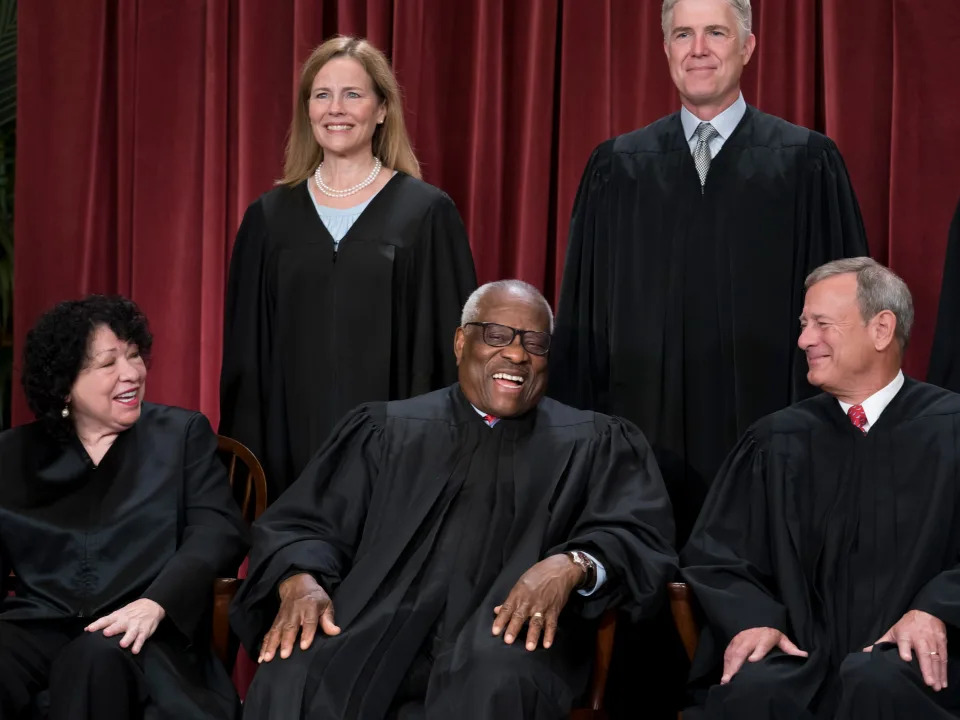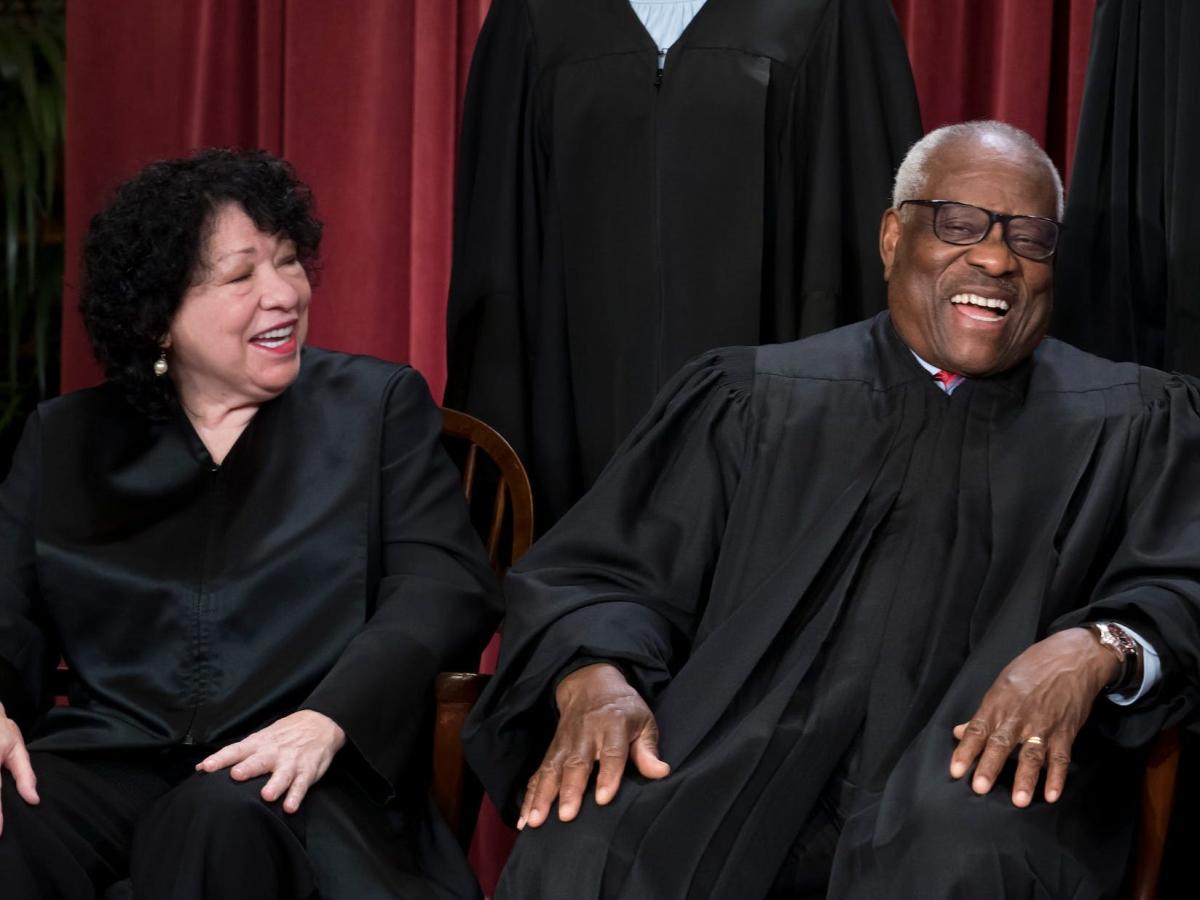That's a new one for me. I am bummed there's not an odds chart I could bet against.

Bottom row, from left, Associate Justice Sonia Sotomayor, Associate Justice Clarence Thomas, and Chief Justice of the United States John Roberts. Top row, from left, Associate Justice Amy Coney Barrett, Associate Justice Neil Gorsuch, and Associate Justice Brett Kavanaugh.AP Photo/J. Scott Applewhite
Specifically, given the latest actuarial data, there's something like a 65% chance one of these people dies before the end of the presidential term the next election will decide.
Is this morbid? Most definitely! Death is an uncomfortable topic. These are human beings, and treating their lives with dignity is important. The thing is, the ramifications of what a Supreme Court can do are vastly more important than the feelings of a couple of justices.
We can plug in their basic vital statistics — age and gender will suffice — and run it through a program outfitted with the latest data from the Social Security Administration when it comes to life expectancy. Perfect? No. Obviously these people have world-class health care, and might differ from the general population in meaningful ways. Useful? Certainly.
All those caveats aside, here's the situation.
We'd expect a group of people resembling the Supreme Court (a 75-year-old man, a 73-year-old man, a 69-year-old woman, and so on) to have a 50% chance of someone dying within 3.9 years.
More pertinent, there's a 21% chance that someone from that hypothetical group of nine people with identical ages and genders to the current Supreme Court will die within 1.5 years, incidentally the amount of time remaining on Biden's term. There's a 65% chance that someone dies within 5.5 years, which would bring us to the inauguration of January 2029, hypothetically.
That implies a 44% chance that the next president will have a shall we say involuntary vacancy on the court to fill. Decent chance.
Of course, one would then want to know from which side those vacancies might come. There is a 6-3 split on the court, with the justices appointed by GOP presidents enjoying a rather substantial lead.
A death of a liberal justice during the next term, if there were a Republican president or Senate, would be objectively a disaster for the Democratic party for decades.
Given a 52-year-old woman, a 69-year-old woman, and a 63-year-old woman and known actuarial data, there's an 18% chance one dies within 5.5 years. Subtracting out the chance of a death within the remaining Biden administration, it's a ballpark 14% chance the next election decides the future of at least one seat currently held by a Democratic justice. That's a dice roll.
Democrats probably need to think about what an acceptable level of risk is for losing control of the Supreme Court for generations. Is it 14%?
Given the GOP controls more seats, and their justices are older, there's a substantially higher chance that the next president will be filling a vacancy in a GOP-held seat on the court.
Among a group of 75-, 73-, 68-, 58- and 56-year-old men and one 51-year-old woman, we'd expect a 57% chance of one death within five and a half years. Subtracting the 17% chance of a death during the final years of Biden's initial term, that means there's a 40% chance of the next president filling a vacancy on the Supreme Court for a seat currently held by a Republican-appointee.
Obviously, justices can and in some cases likely will alter these possibilities by resigning on their own volition if a suitable president is elected.
Justices Sonia Sotomayor or Elana Kagan could retire before the end of Biden's term, and in doing so roughly halve the risk of Democrats losing a seat on the Court in the next term. If a GOP president were elected, Justices Samuel Alito or Clarence Thomas could ensure their judicial legacy lives on by resigning under a Republican.
Not all avail themselves of this opportunity. Justice Ruth Bader Ginsberg decided against retiring during President Obama's term despite a desire from the president to ensure her replacement reflected her liberal values. Now her chair belongs to the Trump-appointee Amy Coney Barrett, who provided the decisive vote to overturn Roe v. Wade.

 www.yahoo.com
www.yahoo.com
Here's the probability a Supreme Court justice dies in the next presidential term
Bottom row, from left, Associate Justice Sonia Sotomayor, Associate Justice Clarence Thomas, and Chief Justice of the United States John Roberts. Top row, from left, Associate Justice Amy Coney Barrett, Associate Justice Neil Gorsuch, and Associate Justice Brett Kavanaugh.AP Photo/J. Scott Applewhite
- The Supreme Court has a major impact on everyday Americans' lives.
- The justices serve for life, and wield enormous power over the future of the country.
- It's important to seriously consider the future of the court.
Specifically, given the latest actuarial data, there's something like a 65% chance one of these people dies before the end of the presidential term the next election will decide.
Is this morbid? Most definitely! Death is an uncomfortable topic. These are human beings, and treating their lives with dignity is important. The thing is, the ramifications of what a Supreme Court can do are vastly more important than the feelings of a couple of justices.
We can plug in their basic vital statistics — age and gender will suffice — and run it through a program outfitted with the latest data from the Social Security Administration when it comes to life expectancy. Perfect? No. Obviously these people have world-class health care, and might differ from the general population in meaningful ways. Useful? Certainly.
All those caveats aside, here's the situation.
We'd expect a group of people resembling the Supreme Court (a 75-year-old man, a 73-year-old man, a 69-year-old woman, and so on) to have a 50% chance of someone dying within 3.9 years.
More pertinent, there's a 21% chance that someone from that hypothetical group of nine people with identical ages and genders to the current Supreme Court will die within 1.5 years, incidentally the amount of time remaining on Biden's term. There's a 65% chance that someone dies within 5.5 years, which would bring us to the inauguration of January 2029, hypothetically.
That implies a 44% chance that the next president will have a shall we say involuntary vacancy on the court to fill. Decent chance.
Of course, one would then want to know from which side those vacancies might come. There is a 6-3 split on the court, with the justices appointed by GOP presidents enjoying a rather substantial lead.
A death of a liberal justice during the next term, if there were a Republican president or Senate, would be objectively a disaster for the Democratic party for decades.
Given a 52-year-old woman, a 69-year-old woman, and a 63-year-old woman and known actuarial data, there's an 18% chance one dies within 5.5 years. Subtracting out the chance of a death within the remaining Biden administration, it's a ballpark 14% chance the next election decides the future of at least one seat currently held by a Democratic justice. That's a dice roll.
Democrats probably need to think about what an acceptable level of risk is for losing control of the Supreme Court for generations. Is it 14%?
Given the GOP controls more seats, and their justices are older, there's a substantially higher chance that the next president will be filling a vacancy in a GOP-held seat on the court.
Among a group of 75-, 73-, 68-, 58- and 56-year-old men and one 51-year-old woman, we'd expect a 57% chance of one death within five and a half years. Subtracting the 17% chance of a death during the final years of Biden's initial term, that means there's a 40% chance of the next president filling a vacancy on the Supreme Court for a seat currently held by a Republican-appointee.
Obviously, justices can and in some cases likely will alter these possibilities by resigning on their own volition if a suitable president is elected.
Justices Sonia Sotomayor or Elana Kagan could retire before the end of Biden's term, and in doing so roughly halve the risk of Democrats losing a seat on the Court in the next term. If a GOP president were elected, Justices Samuel Alito or Clarence Thomas could ensure their judicial legacy lives on by resigning under a Republican.
Not all avail themselves of this opportunity. Justice Ruth Bader Ginsberg decided against retiring during President Obama's term despite a desire from the president to ensure her replacement reflected her liberal values. Now her chair belongs to the Trump-appointee Amy Coney Barrett, who provided the decisive vote to overturn Roe v. Wade.
Real talk? Here's the probability a Supreme Court justice dies in the next presidential term
This election is going to be about a lot of things. One is that the next president has a pretty good chance of filling a Supreme Court vacancy.

